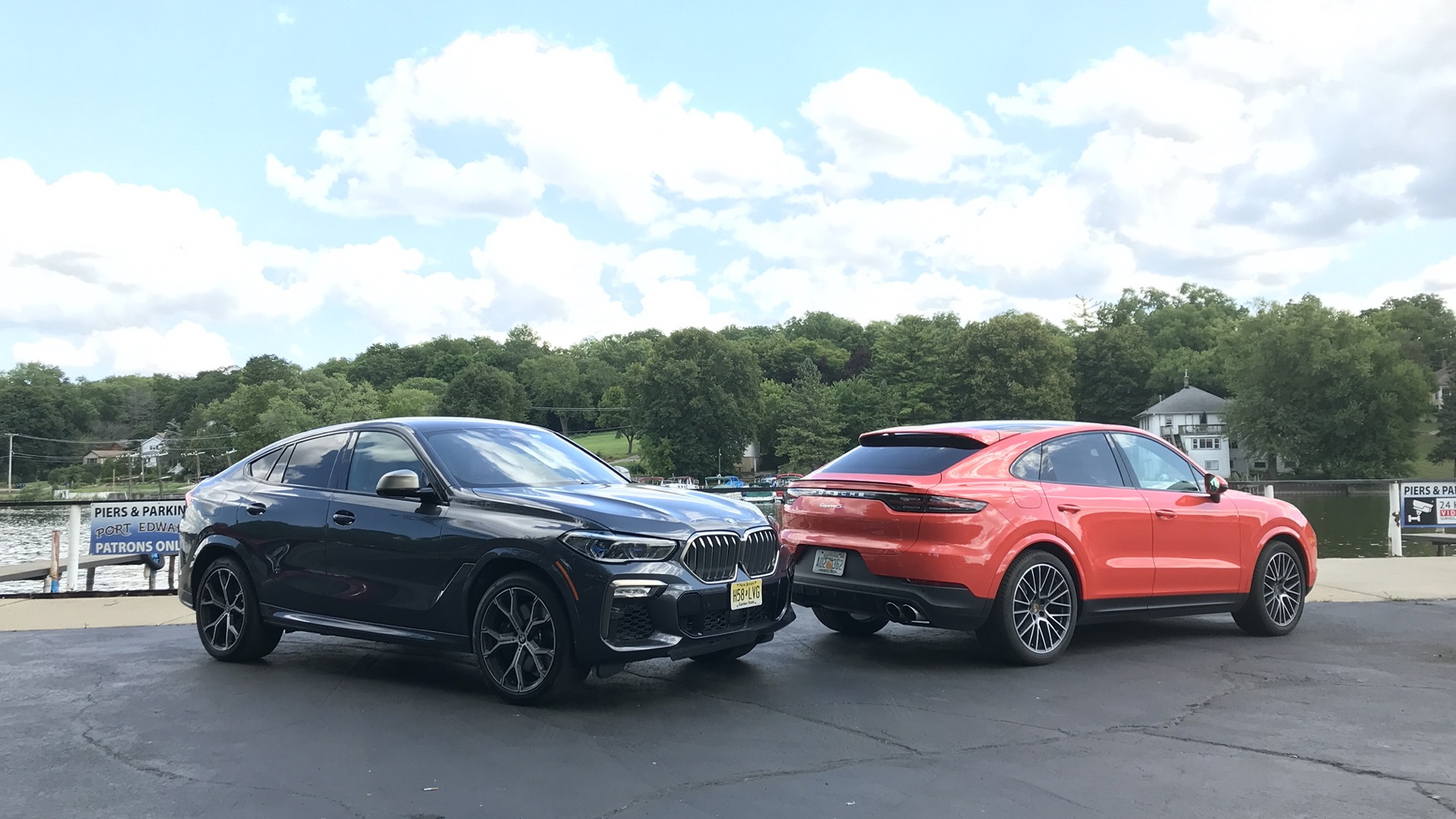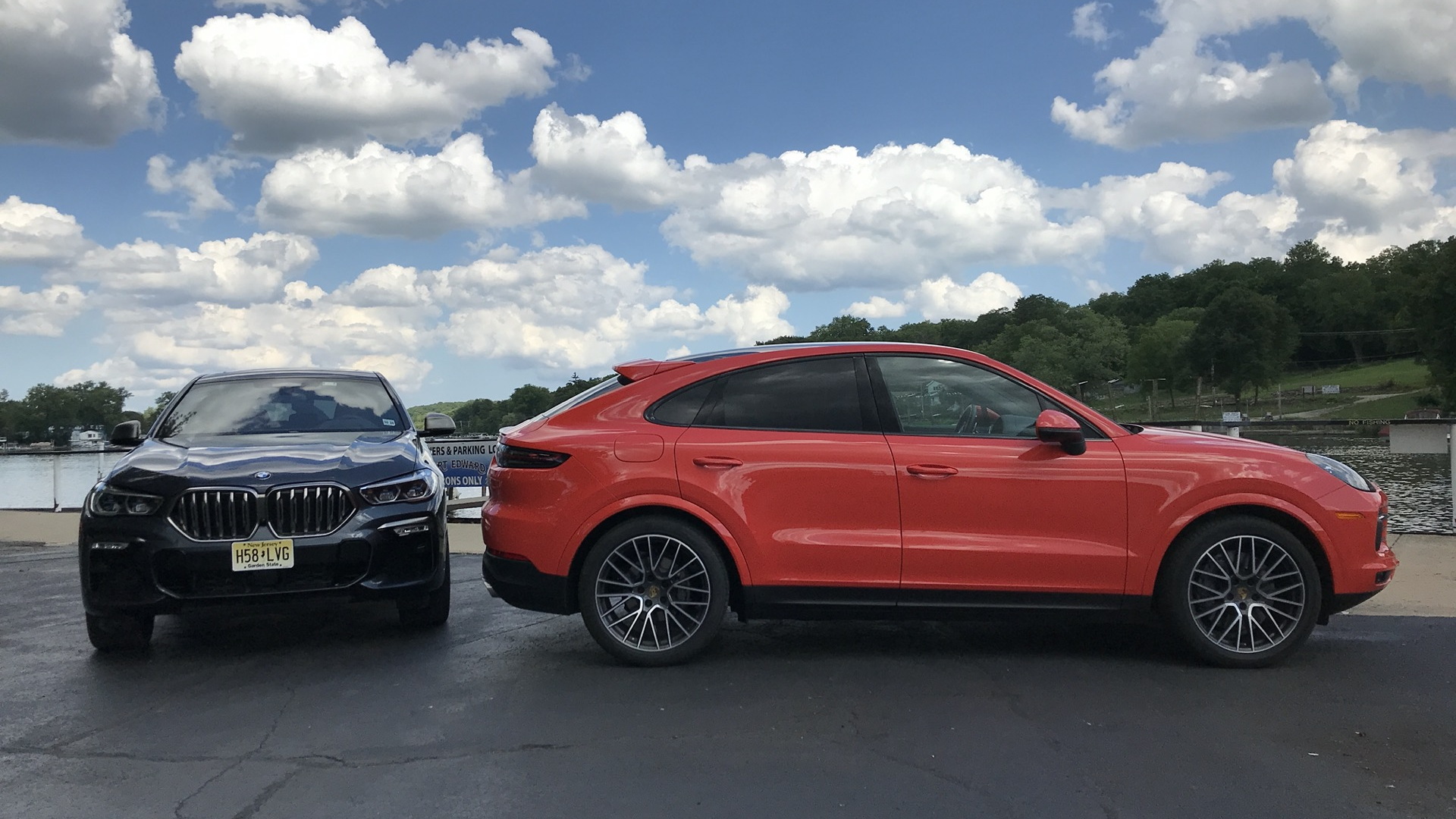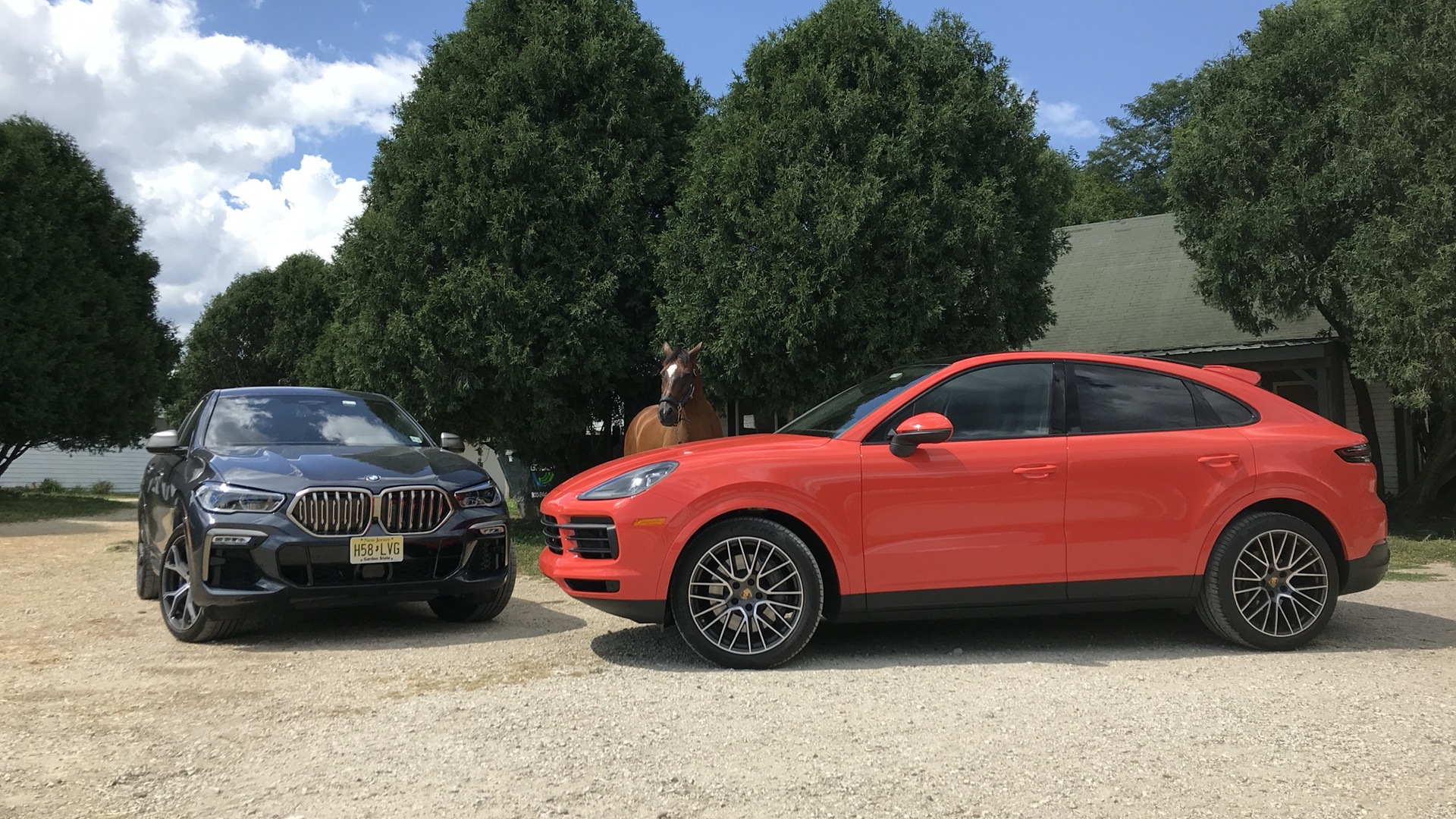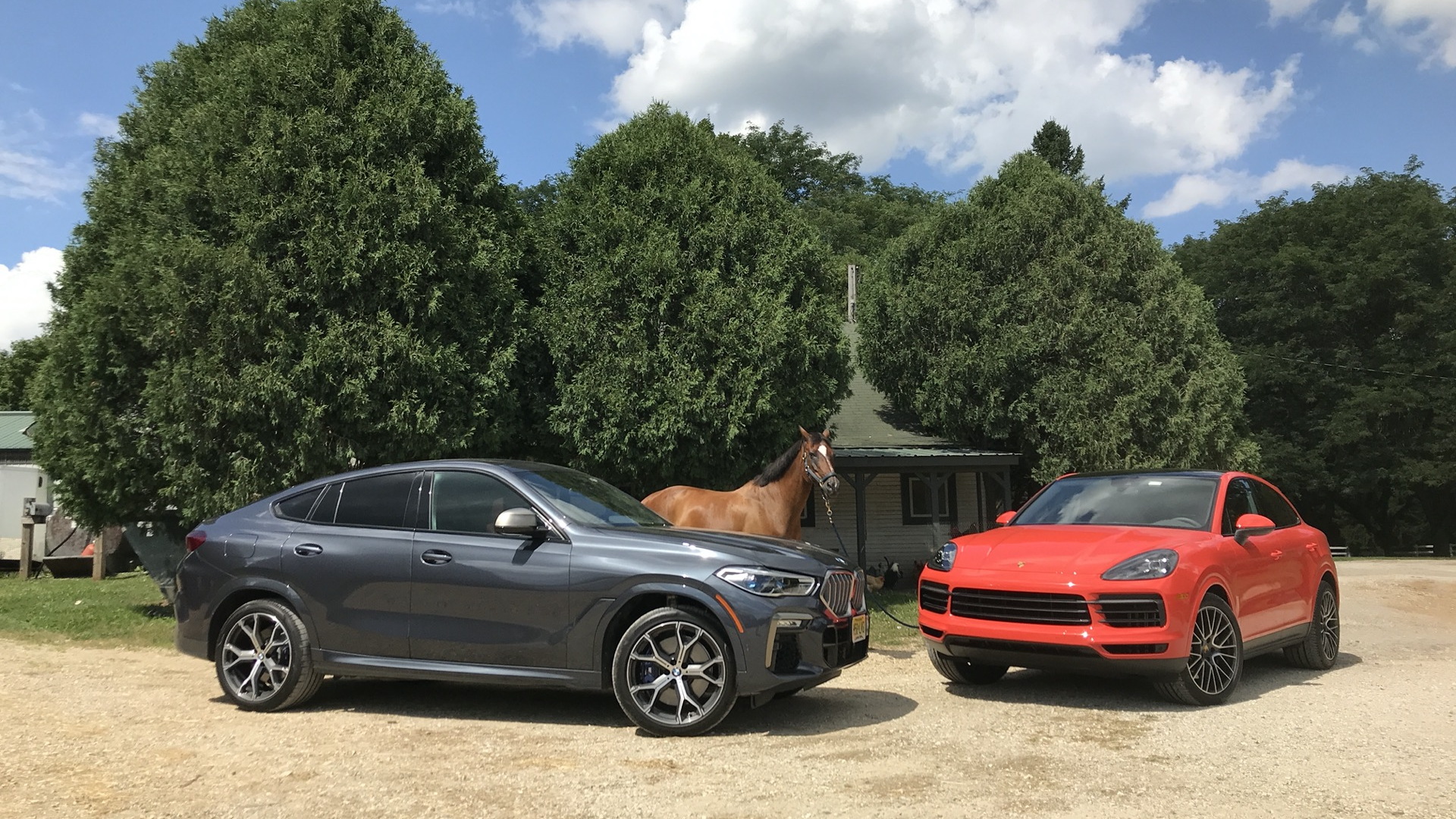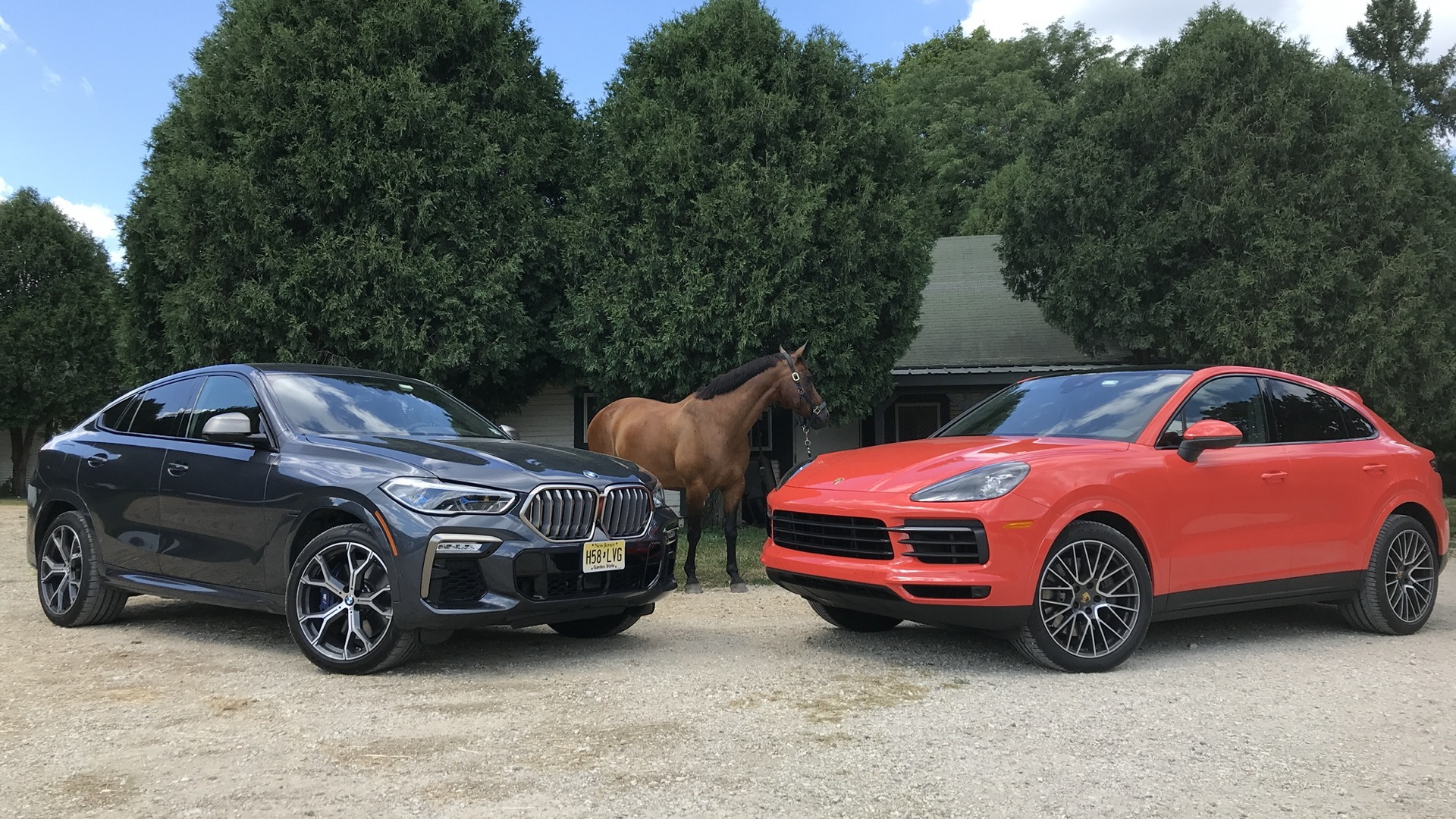Porsche and BMW took almost the exact same approach when developing the 2020 Cayenne Coupe S and the 2020 X6 M50i. Crossover coupes aimed at performance, both pack twin-turbocharged engines, roll on meaty wheels and tires, and feature high-end suspensions. Both trade utility for faster greenhouses, too. They may be crossover coupes, but they’re really disguised sport sedans.
The Car Connection senior editor Robert Duffer and I recently tested both models back to back to see how they compare. Here’s what we learned.

2020 BMW X6 M50i

2020 BMW X6 M50i

2020 BMW X6 M50i
Power and acceleration
Lurking under the hood of the X6 is a twin-turbocharged 4.4-liter V-8 that churns out 523 horsepower and 553 pound-feet of torque. It’s backed by an 8-speed automatic transmission and it sends power to all four wheels. The Porsche features a twin-turbocharged 2.9-liter V-6 that makes 434 hp and 405 lb-ft of torque. It’s also backed by an 8-speed automatic and it also has all-wheel drive.
Between the two, the BMW engine is the clear winner and in more ways than one.
“Like Nuke LaLoosh in ‘Bull Durham,’ the X6 M50i announces its presence with authority,” Duffer noted. “The 4.4-liter twin turbo V-8 leaps off the line to 60 mph in just 4.1 seconds, then snaps, crackles, and pops when you lay off. Porsche’s twin-turbo V-8 can't match the raw power.”
The BMW’s exhaust note is deeper and richer, and its power feels notably stronger. That’s backed up by the 0-60 mph times. The Cayenne S hits 60 mph in 4.7 seconds. Not even the 2021 Cayenne GTS is as quick with its twin-turbocharged 453-hp V-8; it reaches 60 mph in 4.2 seconds. And the Porsche twin-turbo V-6 may have its own rumble, but it’s not nearly as authoritative as the BMW’s.
Advantage: BMW.

2020 Porsche Cayenne Coupe S

2020 Porsche Cayenne Coupe S

2020 Porsche Cayenne Coupe S
Handling
The performance script flipped when we turned the wheels, especially at speed into sharp bends. The Porsche’s steering is more direct, its reactions much quicker, and its nose more planted. The Cayenne’s front end feels much better tied together, and it helps the 4,725-pound Cayenne carve a corner like a scalpel.
By comparison, the 5,115-pound X6 M50i flops into a corner, but it carves sharply after the body has shifted its weight and taken a set. Send the weight back to the other side, though, and the BMW has to find that set again while the Porsche quickly gathers its mass to head in a new direction. Not only is the BMW heavier, it’s also 1.2 inches longer and almost an inch wider and taller.
Both vehicles turn to the bag of suspension tricks to control their size and weight, though many of those features were optional on our testers. Both came with optional active anti-roll bars that help counter body lean, but the adaptive dampers that vary the ride between soft and firm were standard equipment. The BMW’s Dynamic Handling package featured the active anti-roll bars, plus rear-axle steering to virtually shorten the wheelbase and corner sharper at lower speeds. The BMW also came standard with a torque-vectoring M Sport rear differential. The Porsche’s performance options included an air suspension and an electronically controlled torque vectoring rear differential. Porsche also offers rear-axle steering, but this tester didn’t have it.
“I'd take the Cayenne Coupe S on a racetack. It handles much more athletically, and the air suspension lowers the Cayenne to give it sport sedan agility in Sport+ mode,” noted Duffer. I agree.
Advantage: Porsche.

2020 Porsche Cayenne Coupe S

2020 Porsche Cayenne Coupe S

2020 BMW X6 M50i

2020 BMW X6 M50i
Space and luxury
The BMW’s size gives it an advantage in interior space, and BMW goes even further with a true luxury feel. Most notably, the BMW seats five while the Porsche only seats four.
It’s ironic to talk about space in either of these crossover coupes because they were both conceived to sap space from the crossovers they were based on.
Still, with a 3.1-inch longer wheelbase, the BMW provides more rear leg room and a larger cargo area that includes 27.4 cubic feet of space behind the rear seat and 59.6 cubic feet with the rear seat folded flat. That compares to 22 cubic feet and 54.3 cubic feet, respectively, for the Porsche.
We were more impressed with the front seat. Room and comfort for the driver aren’t issues in either model, and both provide supportive, comfortable, well-bolstered seats. However, the BMW had far more seat adjustments (20-way vs. 8-way) and it most impressed with its design and materials.
Our X6 tester’s Tacora Red Vernasca leather played off the aluminum tetragon trim and optional glass controls ($650) to create a high quality and visually interesting environment that felt more upscale than its more-expensive competitor. The Porsche’s cabin, on the other hand, traded in shades of gray. Gray leather with light contrast stitching and piano black trim created a stark, cold, sporty look. It still featured soft-touch surfaces and exemplary fit and finish, but didn’t look or feel as luxurious.
Both vehicles also boasted large touchscreen infotainment systems that each stood out for different reasons. We loved the Google Maps view in the Porsche, but we found the BMW system easier to understand and operate.
Advantage: BMW.

2020 BMW X6 M50i, left, and 2020 Porsche Cayenne Coupe S, right
Design
Porsche design comes from Porsche history. Every vehicle in the lineup incorporates cues from Porsches of the past, mostly from the 911. This approach works slightly better than BMW’s take on the crossover coupe, likely because the Porsche has fewer lines.
The Cayenne Coupe’s nose is pure Porsche, rounding down from the hood to a single, lower grille flanked by large air intakes and topped by alien-eye headlights. Along the sides, the look is more traditional SUV but with a faster rear roofline than the already fast Cayenne SUV. Big tires fill the wheel wells and work with a pronounced rear roof spoiler to announce the Cayenne S Coupe’s performance intent.
The BMW is more angular with more character lines and flourishes that make it seem busy. The BMW twin-kidney grille fronts a more intricate nose that also features large air intakes at the corners. Along the sides, a shoulder line that starts at the taillights and angles downward toward the front gives the BMW a rake and a sense of motion. BMW tries to hide the SUV roots with a roofline that starts falling right behind the driver. The tall tail gets horizontal taillights and large exhaust outlets at the corners without a lot of design in between.
“Porsche better retains its DNA in the design of the Cayenne Coupe. It looks more fluid and elicits more stares, whereas the X6 can look like a top piece stuck on a lower piece,” said Duffer.
Advantage: Porsche.

2020 BMW X6 M50i

2020 BMW X6 M50i

2020 Porsche Cayenne Coupe S
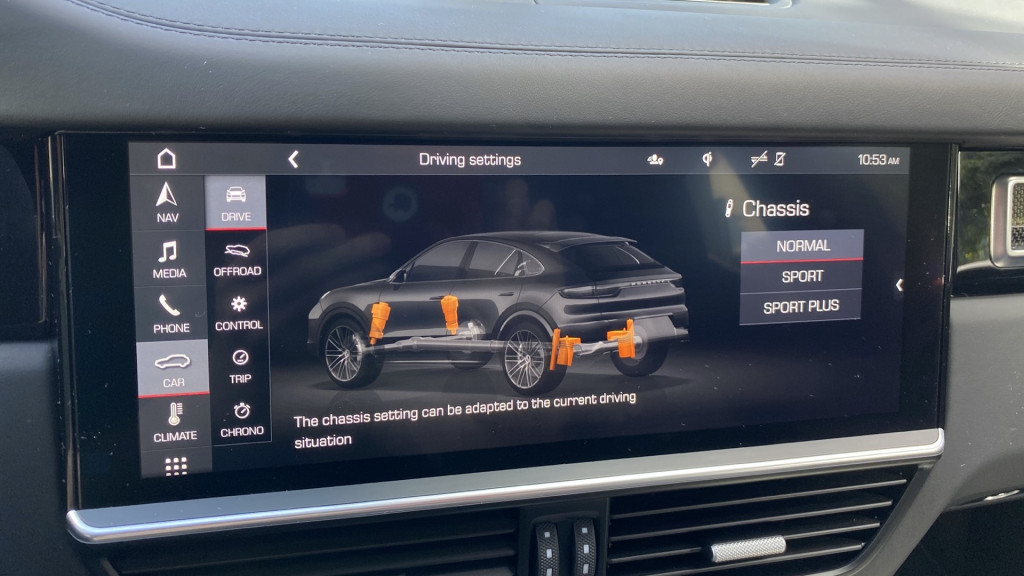
2020 Porsche Cayenne Turbo S E-Hybrid Coupe drive review - July 2020
Features
Our test cars started at similar prices, the Porsche at $89,950 and the BMW at $86,645. Both featured more than a few options, though, and Porsche charged more for them. The options brought the Porsche to $108,050 and the BMW to $97,195. This is indeed a $200,000 battle of performance crossover coupes.
Many of the advanced suspension features we tested were optional. The BMW’s Dynamic Handling package runs $2,600 and includes the rear-axle steering, active anti-roll bars, and adaptive dampers. Porsche charges more for its suspension goodies. The air suspension runs $2,170, the active anti-roll bars cost a hefty $3,590, and the torque vectoring rear differential will set you back $1,500.
That sterile gray leather in the Porsche was a $3,750 option; otherwise, the interior gets only partial leather. The Lava Orange paint cost $3,250. Porsche also charges for heated front seats ($530) and auto-dimming mirrors ($420) that are standard in the BMW.
The BMW comes with more amenities as well. It gets a branded stereo with more power and more speakers (464 vs 150 watts and 16 vs. 10 speakers), wireless device charging, more seat controls, four-zone vs. dual-zone automatic climate control, a power-adjustable steering column, and more safety features, including adaptive cruise control, lane departure warnings, and blind-spot monitors.
Advantage: BMW.

2020 BMW X6 M50i, left, and 2020 Porsche Cayenne Coupe S, right
The decision
By the numbers, this is a win for BMW. It’s quicker, roomier and more luxurious inside, and it comes with more equipment at a lower price. The Porsche, on the other hand, is better looking and more agile thanks to Porsche engineering and less weight.
Still, the competition is close enough to make this a call based on preference. We’d rather drive the Porsche on a twisty road, but we’d rather live with the BMW for its added luxury, incredible power, and lovely engine note. It’s hard to call either of these expensive crossover coupes a value, but they both fulfill their missions as raised sport sedans in crossover clothing.
